|

A JOURNEY THROUGH PERU

Dear Travel Partner,
Peru is a land of mysteries, legends, and ancient cultures. Today, we want to take you on a journey through its different regions and varied landscapes: from the arid desert and sand dunes on the coast, along the snow-capped mountains and volcanoes of the Andes, to the lush Amazon rainforest and finally the mysterious northern region.
To get you in the right mood, we have a quick and easy recipe for you to try so you can enjoy a delicious Peruvian "Lomo Saltado" at home!
Our SAT Peru team is always happy to help you create new travel ideas and realize your clients' dream journeys!
Currently, they are working from home and we thought it would be nice to share a little impression of their personal offices.
All the best,
your SAT Team
|
|
*** Temporary office hours (Monday-Friday) ***
|
| SAT Argentina: |
09:00h - 14:30h |
| SAT Brazil: |
09:00h - 13:30h |
| SAT Chile: |
09:00h - 15:30h |
| SAT Colombia: |
09:30h - 17:30h |
|
|
|
|
| SAT Ecuador: |
09:30h - 17:30h |
| SAT Peru: |
08:00h - 14:00h |
| SAT Uruguay: |
09:30h - 13:30h |
|
 |
|
 |

|
 |
|
 |
 |
|
Lomo Saltado is a delicious beef stir fry which is traditionally served with a side of rice - it is a Peruvian all-time favorite! The preparation is simple and few ingredients are needed. Here is the recipe for 4 servings:
500gr (1.1lb) sirloin steak (thin slices)
400gr potatoes (cut into French fries)
1 red onion (thick slices)
2 tomatoes (deseeded, thick slices)
2 garlic cloves (minced)
1 aji amarillo (yellow hot pepper, deseeded, thin slices)
salt and pepper to taste
3 tablespoons vegetable oil
3 tablespoons soy sauce
3 tablespoons red wine vinegar
fresh cilantro (coarsely chopped)
Distribute the French fries evenly in one layer on a baking tray. Sprinkle with 1 tablespoon of vegetable oil, season with salt and pepper to taste. Bake in the oven until golden brown and crispy (approx. 35min, 200°C), turning the potatoes 1-2 times during baking.
In a large pan heat 1 tablespoon of oil over high heat and sear the meat until browned, season with salt and pepper (approx. 5-6 min). Remove the meat from the pan.
In the same pan, add 1 tablespoon of oil and sauté the onion and garlic for 5 minutes. Add the tomatoes and yellow pepper and cook for another 5 minutes, season with salt and pepper.
Add the soy sauce and vinegar and cook for 1 minute to combine. Then add the meat, French fries and cilantro and toss gently.
Serve immediately with a side of cooked white rice and dig in!
|
 |
|
 |
|
LIMA: CAPITAL AND CULINARY PARADISE
|
 |
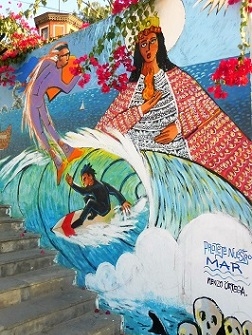 |
|
Lima, also known as the “City of Kings”, is located directly on the Pacific coast. Peru’s capital city is a melting pot of cultures where you will encounter people, flavors, and history from different regions. The bustling metropolis has something for all tastes and ages: exquisite, internationally-praised cuisine, countless museums covering all aspects of Peruvian culture, a stunning historical center which is also a UNESCO World Heritage Site and diverse neighborhoods, like the bohemian district of Barranco. All over the city there are
beautiful murals and art works just waiting to be admired.
If you want to get active, you can rent a bike to explore the city or head to the shore for a surf lesson.
The city is also a great starting point for excursions to nearby sights, like the archeological Inca site Pachacamac (33km from Lima). Or how about a boat tour to Palomino Islands? They are home to seabirds, sea lions and the second biggest colony of Humboldt penguins! Those who don't mind a longer drive can visit Caral, the ruin site of the most ancient city of the continent (200km from Lima).
|
 |
|
 |
|
ICA: PISCO, WINE AND HISTORY
|
 |
|
The Province of Ica is located on the central south coast of the Peruvian seaside and is recognized as a region of desert and sea, sand dunes and valleys, ancient cultures. Its most important cities are Ica, Paracas, Pisco and Nasca.
The important pre-Inca civilizations of Paracas (700 years B.C.) and Nasca (300 years B.C.) developed here. The men of Paracas practiced the trepanation of skulls on living bodies using knives made of obsidian. They also achieved great developments in the art of weaving. The Nasca culture stood out for its knowledge of hydraulic engineering, building aqueducts and subterranean canals reinforced by inner walls of stone and roofs of huarango.
One of the region's most famous landmarks are the Nazca Lines, ancient geoglyphs in the desert that can be observed during overflights. It is also the center of Pisco production, a local brandy and national spirit of Peru. There are countless wineries that welcome visitors and offer tastings of both Pisco and wine. Off the coast you can visit the Ballestas Islands which are home to sea lions, fur seals, blue-footed boobies and Humboldt penguins. Just a few kilometers from Nasca you can visit the Chauchilla cemetery where the dry desert climate has preserved prehispanic human
remains and artifacts.
|
|
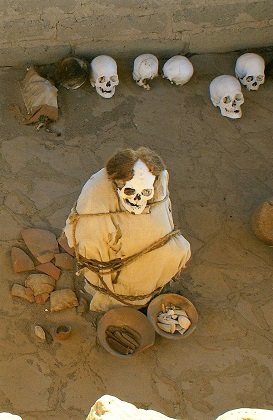 |
 |
|
 |
|
SAT TIP: SELF-DRIVE ROUTE "SUR CHICO"
|
|
The region of Ica, also known as "Sur Chico" is a great destination for a self-drive trip from Lima. In approx. 3.5h, you reach the coastal town Paracas, the perfect base to explore the surroundings. Besides several wineries and the Ballestas Islands, you can visit the Huacachina Oasis which is located 1.5h from Paracas. Flights over the Nasca Lines leave from Pisco and Ica. If you want to make your way to Nasca Town to visit the Chauchilla cemetery, the drive from Paracas takes another 3.5h. Accommodation is available in Paracas, Ica and Nasca.
|
 |
|
 |
 |
 |
|
Arequipa, the white city, is located at 2,335m (7,660ft.) above sea level, in a fertile valley surrounded by majestic snow-capped volcanoes. It boasts a unique architecture: as you wander the streets, admire its breath-taking plaza, baroque-style churches, and colonial mansions made of white volcanic stone called “sillar”. A visit to the local quarries shows how the stone is obtained. You can learn about the ancient processes and instruments used to extract, cut, and carve the volcanic ashlar stones and see expert quarry masters at
work. One of the Arequipa's highlights is the Santa Catalina Monastery, a 20,000m2 (215,278ft2) complex that is considered a “City within the City”. Before being opened to the public in 1970, nuns lived here completely isolated from the outside world for over 400 years. Arequipa is also renowned for its gastronomy! You should definitely give the delicious local dishes a try, like "rocoto relleno", stuffed spicy red peppers.
Outside the city, one of the world's deepest canyons is waiting: Colca Canyon with a depth varying between 1,800m and 3,400m (5905ft-11154ft)! On the way there, you will pass through different ecological zones like the desert, the “altiplano”, and the dry tundra. Keep an eye out for herds of wild vicuñas, relatives of the llama and alpaca. From the “Cruz del Condor” viewpoint, you can spot the immense Andean Condors as they fly and hunt for food. Colca also offers a variety of incomparable activities such as river rafting, mountain biking,
horseback riding and amazing hikes.
|
 |
|
 |
|
SAT TIP: ACCOMMODATION AT BELMOND LAS CASITAS
|
|
The 24hectar huge hotel area is located in the heart of the Colca Valley and comes with 20 private houses built in a local architectural style. Each of them is equipped with a private terrace with a small heated swimming pool - perfect to relax and enjoy the view. Several activities are included during the stay, like a cooking class (30min), a Pisco Sour class (30min) or trout fishing (1h).
|
|
PUNO: GATEWAY TO LAKE TITICACA
|
 |
|
Puno is located on the shores of Lake Titicaca (3,812m/12,506ft), the world’s highest navigable lake. The city is also known as the folklore capital. In February, it hosts important celebrations and receives around 50,000 artists that fill the streets with their music, traditional dances, and vibrant colors. On Sundays, there is a traditional Aymara Market where you will find a large variety of fruits and vegetables, as well as handicrafts.
There is also lots to see outside the city! 35km (21mi) from Puno, you can visit the archaeological site of Sillustani, a pre-Inca cemetery with aboveground burial towers (chullpas) that can reach up to 12m (39ft.). Located near the city of Jaycu Marca, you can explore the temple of Aramu Muru, a carved portal made of gigantic flat stones, which is believed to be the entrance to another dimension.
Then of course there is Lake Titicaca itself. Don’t miss a visit to the Uros floating islands made from dried Totora reeds, where the residents have preserved their culture and fascinating way of life. On Taquile Island, you can learn about the unique local traditions based on community collectivism. Did you know that Taquile's men are famous for knitting hats? If you are looking for a homestay-experience, make your way to Amantani Island where hospitable families open their homes to guests.
|
|
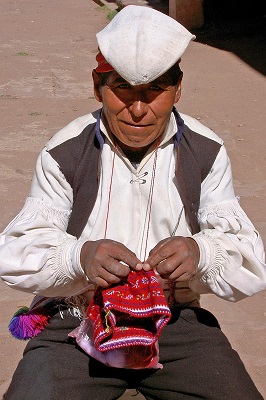 |
 |
|
 |
CUSCO, SACRED VALLEY AND MACHU PICCHU
|
 |
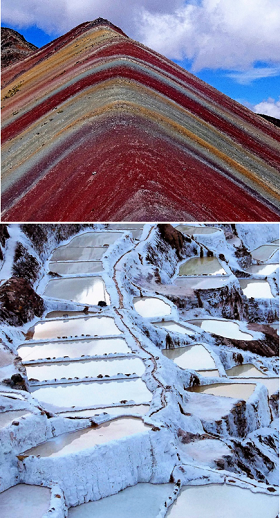 |
|
Cusco, located at 3,400m (11,150ft), was the heartland of the Incan Empire. The city blends ancient Andean cultures with Spanish colonial splendor. Visit nearby Inca citadels and temples like “Qorikancha” or “Saqsaywaman”, or admire the colonial mansions, balconies, and churches throughout the city. As you stroll along the cobblestone streets, you can appreciate the colorful textiles, handicrafts, and art galleries.
A short drive from Cusco leads to the Urubamba Valley or Sacred Valley, located at approximately 2800m (9186ft). As you drive through the winding roads, stop to explore many fascinating ruins, citadels, and agricultural terraces. Some of the Sacred Valley’s favorite attractions include the Pisac market, the Ollantaytambo ruins, the salt ponds of Maras, circular agricultural terraces of Moray, and the weaving village of Chincheros. You can also experience the daily life of the local communities by joining them in their collective work on the fields or in
craft workshops.
After having crossed the Sacred Valley you reach Machu Picchu - undoubtedly one of the “must-see” archeological sites in the world. The most remarkable site from the Inca Empire was never found by the Spaniards and was re-discovered during the 20th century. Since then, archeologists continue to investigate, excavate, and reconstruct the ancient city that used to serve as a political, religious, and administrative center. Temples, agricultural terraces, and archeological observatories enclose a history and a mystery that go back thousands of
years.
|
 |
|
 |
|
SAT TIP: REMOTE TREK TO RAINBOW MOUNTAIN
|
|
Most outdoor fans tend to venture from Cusco through the Sacred Valley towards Machu Picchu. But did you know that there are equally exciting options in the opposite direction of Cusco that are much less frequented? One of them is the hike to Vinicunca, the Rainbow Mountain. Its multi-colored slopes caused by different mineralogical compositions result in a breathtaking sight that is well worth the exhausting journey. The routes traverse an unbelievably beautiful landscape, including snow-capped mountain tops, picturesque valleys, gorges, lagoons,
and even waterfalls. Along the way, a number of animals can be spotted, like alpacas, Andean geese or vizcachas (chinchilla family).
|
|
THE AMAZON: A LUSH WONDERLAND
|
 |
|
Peru has two main destinations in the Amazon region, Puerto Maldonado and Iquitos. The decision where to go depends mainly on how you want to experience the Amazon: during a lodge stay or a cruise. When it comes to wildlife sightings, both experiences are quite similar as both programs include excursions by boat as well as jungle walks to explore flora and fauna. One of the main differences between the two is that a cruise is able to cover a bigger area and therefore a larger diversity of habitats whereas a lodge is confined to a certain area which allows a
more in-depth exploration. Another big difference is the way you experience your surroundings. Most lodges have a very open and airy construction of rooms and public areas to make their guests feel like they are immersed in the jungle. It is not uncommon to find frogs or lizards in your room. Cruise ships on the other hand offer a more contained hotel-like environment - no surprise visitors here!
Puerto Maldonado is the capital of the Madre de Dios region and perfect for lodge stays. At the confluence of the Tambopata and Madre de Dios Rivers, it now has many protected parks and natural reserves. Its beautiful landscapes and virgin rainforest hide an incredible biodiversity with unique fauna and flora. There is no doubt that Puerto Maldonado will allow travelers to see, feel, and hear the Amazon first hand.
Iquitos is the largest city in Peru’s tropical rainforest and it can only be reached by airplane or by boat. It is where to go for Amazon cruises and home port to a variety of vessels. Nearby, the bustling market in Belén will introduce you to exotic fruits and dare you to try unique cuisine like “Suri”: a worm considered a nutritious delicacy by locals.
|
|
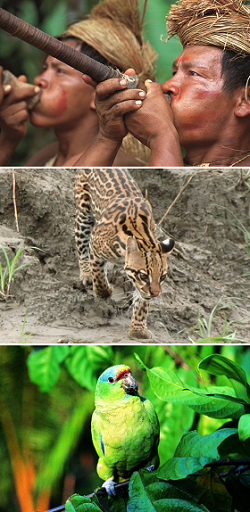 |
 |
|
 |
|
SAT TIP: TAMBOPATA RESEARCH CENTER
|
|
If you are looking for a solitary way to experience the Peruvian Amazon, the Tambopata Research Center is as remote as it gets. The lodge is located in the middle of the uninhabited portion of the Tambopata National Reserve. Originally functioning as a research center which studied the nearby world’s largest macaw clay lick, it now also receives visitors in 24 rooms. The room side that looks out to the forest does not have a wall or screening of any kind, acting as a large window facing the forest. Guests can create their own á-la carte experience
and choose between more than 15 activities.
|
|
PERU'S NORTH: UNEXPECTED TREASURES
|
 |
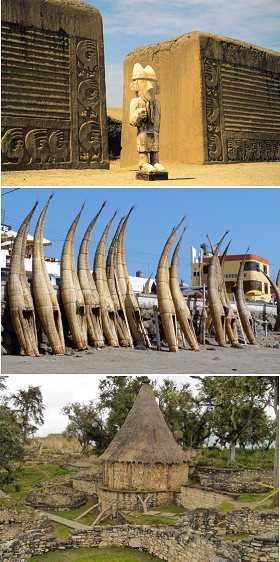 |
|
The pristine and mysterious North of Peru remains largely unexplored by most of the country's visitors although there is so much to see: incredible archaeological excavations, well-preserved mummies, beautiful landscapes and waterfalls and delicious food are just a few of the things the northern region offers! There are three main destinations:
Trujillo is a coastal city that combines colonial splendor with pre-Incan cultural history. “The City of Eternal Spring” is renowned for its typical marinera dance, Peruvian Paso horses, and nationally acclaimed food. Nearby, Chan Chan, a UNESCO World Heritage site, was the Chimú culture’s capital and is the biggest adobe city in the world. Huanchaco is a small beach town where people still fish and surf with “caballitos de totora”, typical embarkations from the Mochica culture.
Chiclayo is located in a fertile valley in the north of the country, and the city’s agricultural activities are very important especially for rice, sugar cane, and cotton. Many pre-Incan cultures such as Lambayeque, Mochica, and Chimú settled here centuries ago. Chiclayo offers visitors an unforgettable and diverse experience with its typical handicrafts, traditional dances, sandy beaches, archaeological sites, and endangered endemic birds like the White-Inged Guan, the Peruvian Plantcutter, and the Rufous Flycatcher.
Chachapoyas is located in the northern Amazon region. This pleasant colonial settlement makes an excellent base to explore the ancient ruins from the Chachapoyas civilization. In the cloud forest hide some of Peru’s most fascinating archaeological treasures like Kuelap or the Karijia sarcophagus, as well as Gocta, one of the world’s highest waterfalls measuring 771m (2529ft).
|
 |
|
 |

|
 |
|
 |
South American Tours - Global Sales Office
South American Tours GmbH | Kaiserstr. 23 | 60311 Frankfurt am Main | Germany
Phone: +49 (0) 69 4058970 | Fax: +49 (0) 69 40589799
Mail: sales@southamericantours.com | www.southamericantours.com
South American Tours - Sales Office North America
Mail: sales-america@southamericantours.com
Copyright © South American Tours 2012-2020
Imprint
South American Tours de Uruguay Agencia de Viajes S.A. | Buenos Aires 618, Piso 2, Oficina 201 | 11000 Montevideo | Uruguay
Tel.: +59 82 91 60 050 | Fax.: +59 82 91 55 406 | E-mail: info@southamericantours.com
Managing Director: Federico Büker | Registered Office: Montevideo | Local Court: Montevideo | Commercial Register: 1194 (Ministry of Tourism) | VAT identification no.: 215224020014

|
|
Protection of data privacy and cancellation of the subscription:
This message has been sent to klonny@southamericantours.com. If you do not want to receive mails in the future you can unsubscribe by clicking
here.
|
|
|
 |
|
 |
 |
|
|